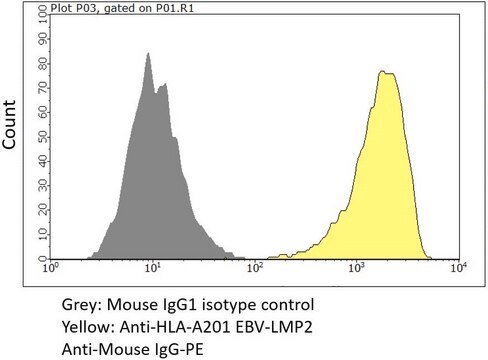MABF2248
Anti-EBV LMP1 Antibody, clone S12
Zaloguj sięWyświetlanie cen organizacyjnych i kontraktowych
About This Item
Kod UNSPSC:
12352203
eCl@ss:
32160702
NACRES:
NA.41
Polecane produkty
forma przeciwciała
purified antibody
klon
S12
monoclonal
oczyszczone przez
using protein G
reaktywność gatunkowa
mouse, virus
stężenie
(Please refer to lot specific datasheet.)
metody
flow cytometry: suitable
immunocytochemistry: suitable
immunofluorescence: suitable
immunohistochemistry: suitable
immunoprecipitation (IP): suitable
western blot: suitable
izotyp
IgG2aκ
numer dostępu UniProt
Opis ogólny
A fusion protein (pKH548) consisting of 189 amino acids from the C-terminus region of LMP1 coupled to beta-galactosidase.
Specyficzność
Clone S12 is a mouse monoclonal antibody that specifically detects Latent membrane protein 1 (LMP1) in Epstein-Barr virus transformed cells.
Zastosowanie
Immunocytochemistry Analysis: A representative lot detected EBV LMP1 in Immunocytochemistry applications (Xu, J., et. al. (2002). J Virol. 76(8):4080-6).
Flow Cytometry Analysis: A representative lot detected EBV LMP1 in Flow Cytometry applications (Mann, K.P., et. al. (1985). J Virol. 55(3):710-20).
Western Blotting Analysis: A representative lot detected EBV LMP1 in Western Blotting applications (Choi, I.K., et. al. (2018). Proc Natl Acad Sci USA. 115(4):E686-E695; Young, L.S., et. al. (1988). J Gen Virol. 69 ( Pt 5):1051-65; Mann, K.P., et. al. (1985). J Virol. 55(3):710-20).
Immunofluorescence Analysis: A representative lot detected EBV LMP1 in Immunofluorescence applications (Mann, K.P., et. al. (1985). J Virol. 55(3):710-20).
Immunohistochemistry Analysis: A representative lot detected EBV LMP1 in Immunohistochemistry applications (Brink, A.A., et. al. (1997). J Clin Pathol. 50(11):911-8; Khabir, A., et. al. (2005). Virol J. 2:39).
Immunoprecipitation Analysis: A representative lot immunoprecipitated EBV LMP1 in Immunoprecipitation applications (Young, L.S., et. al. (1988). J Gen Virol. 69 ( Pt 5):1051-65).
Flow Cytometry Analysis: A representative lot detected EBV LMP1 in Flow Cytometry applications (Mann, K.P., et. al. (1985). J Virol. 55(3):710-20).
Western Blotting Analysis: A representative lot detected EBV LMP1 in Western Blotting applications (Choi, I.K., et. al. (2018). Proc Natl Acad Sci USA. 115(4):E686-E695; Young, L.S., et. al. (1988). J Gen Virol. 69 ( Pt 5):1051-65; Mann, K.P., et. al. (1985). J Virol. 55(3):710-20).
Immunofluorescence Analysis: A representative lot detected EBV LMP1 in Immunofluorescence applications (Mann, K.P., et. al. (1985). J Virol. 55(3):710-20).
Immunohistochemistry Analysis: A representative lot detected EBV LMP1 in Immunohistochemistry applications (Brink, A.A., et. al. (1997). J Clin Pathol. 50(11):911-8; Khabir, A., et. al. (2005). Virol J. 2:39).
Immunoprecipitation Analysis: A representative lot immunoprecipitated EBV LMP1 in Immunoprecipitation applications (Young, L.S., et. al. (1988). J Gen Virol. 69 ( Pt 5):1051-65).
Jakość
Evaluated by Western Blotting in Raji cell lysates.
Western Blotting Analysis: 1 µg/mL of this antibody detected LMP1 in lysates from Raji cells.
Western Blotting Analysis: 1 µg/mL of this antibody detected LMP1 in lysates from Raji cells.
Właściwości fizyczne
~59 kDa observed; 41.98 kDa calculated. Uncharacterized bands may be observed in some lysate(s).
Postać fizyczna
Purified mouse monoclonal antibody IgG2a in buffer containing 0.1 M Tris-Glycine (pH 7.4), 150 mM NaCl with 0.05% sodium azide.
Przechowywanie i stabilność
Stable for 1 year at 2-8°C from date of receipt.
Inne uwagi
Virus transformed human cells.
Oświadczenie o zrzeczeniu się odpowiedzialności
Unless otherwise stated in our catalog or other company documentation accompanying the product(s), our products are intended for research use only and are not to be used for any other purpose, which includes but is not limited to, unauthorized commercial uses, in vitro diagnostic uses, ex vivo or in vivo therapeutic uses or any type of consumption or application to humans or animals.
This page may contain text that has been machine translated.
Certyfikaty analizy (CoA)
Poszukaj Certyfikaty analizy (CoA), wpisując numer partii/serii produktów. Numery serii i partii można znaleźć na etykiecie produktu po słowach „seria” lub „partia”.
Masz już ten produkt?
Dokumenty związane z niedawno zakupionymi produktami zostały zamieszczone w Bibliotece dokumentów.
Nasz zespół naukowców ma doświadczenie we wszystkich obszarach badań, w tym w naukach przyrodniczych, materiałoznawstwie, syntezie chemicznej, chromatografii, analityce i wielu innych dziedzinach.
Skontaktuj się z zespołem ds. pomocy technicznej







